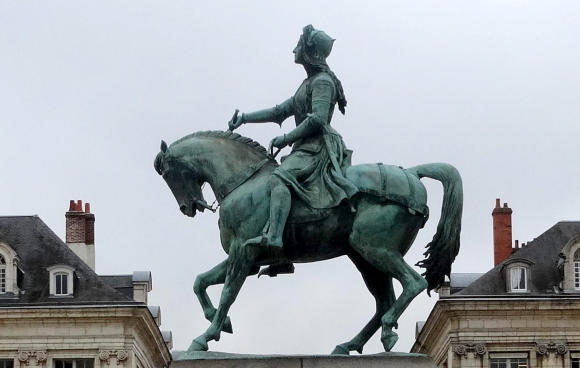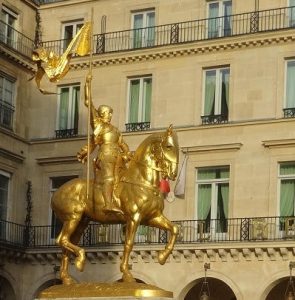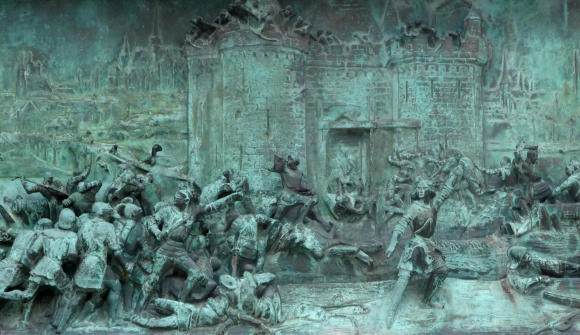
Mayor Olivier Carré of Orléans, left, and Mayor Mitch Landrieu of New Orleans in Orleans. © Mairie d’Orléans-Jean Puyo.
Orléans and New Orleans have been bound by name ever since the latter’s founding as a French colony in 1718, when it was christened in honor of Philippe, Duke of Orleans. But it wasn’t until January 5 this year that the French city on the northern tip of the Loire and the American city on a southern bend of the Mississippi formerly declared themselves related. Sisters, in fact, as Mayor Olivier Carré of Orleans and Mayor Mitch Landrieu of New Orleans signed a sister-city pact.
In November last year, Mayor Landrieu et al. had come calling on Mayor Carré in Orléans (photo above), with other stops in Paris and Monaco.The formal signing took place in New Orleans on the return visit when Mayor Carré led a delegation of Orleanais to visit their New Orleanian counterparts.

The occasion for this sister act is the 300th anniversary of the founding of New Orleans within the territory of Louisiana, itself named in honor of King Louis XIV in 1682. Philippe d’Orléans, the king’s nephew, wasn’t just any old duke. After Louis XIV’s death in 1715, Philippe was appointed as regent of France to oversee the kingdom during the youth of the next King Louis, who was 5 years old when he became the XVth. Phil was therefore the man to honor in 1718.
The recent signing was also timed to coincide with New Orleans’ annual celebration on January 6 of Joan of Arc’s birthday, which includes a parade and festivities honoring the city’s French cultural heritage.

While Joan’s birthday is otherwise overshadowed by Mardi Gras as far as festivities go in New Orleans, she receives perpetual honors as a heroine in Orleans. It was, after all, at the gates of Orleans that her reputation took a great leap when she led the charge to help lift the English siege of the city on May 8, 1429. The French victory at Orléans proved to be a major turning point in the Hundred Year’s War against the English. It launched a series of French victories that restored and enhanced the king’s position, helped open the route to Reims for the official coronation of Charles VII, and eventually chased the English from most of the continent. Think of it as the D-Day of the Hundred Year’s War.
An image in relief on the heroine’s statue at the center of Orléans’ oversized central square, Place du Martoi, shows Joan leading the charge during the siege that earned her the moniker of Maid of Orleans (la Pucelle d’Orléans).
That statue, shown at the top of this article, was damaged during the Second World War and restored in 1950 in part thanks to donations from the City of New Orleans.

New Orleans eventually received its own statue of Joan, “A gift from the people of France to the citizens of New Orleans,” as is written on the pedestal. Erected in 1972, that one is a copy of state-sponsored gilt statue by Emmanuel Frémiet first placed on Place des Pyramides in Paris in 1874. Philadelphia and Portland also have copies, as does Melbourne, Australia, and six other cities in France.
Orléans’ Joan of Arc Festival (Fêtes Johannique) in early May, culminating on the 8th, is the highlight of the festival schedule of the city. As part of the the sister-city exchange this year, New Orleans will be the guest of honor at the festival (French President Emmanuel Macron may also attend), whilc also taking part in Orléans’ annual Foirexpo fair, April 6-15 , and Gastronomy Fair, Nov. 23-26. During the summer a pop-up boutique will sell goods from Louisiana. Other sporting and educational exchanges are also planned. In the longer term, the two cities have agreed to express their sisterhood in exchanges and discussions relative to water issues, tourism, culture and heritage, economics, and education and training.
For further tourist information about Orléans see the site of the Orléans Tourist Office. For information about the surrounding countryside see the site of the Loiret Tourist Board.
Elsewhere in the Loire Valley, Tours is sisters with Minneapolis and Trois-Rivières (Quebec), Nantes is sisters with Jacksonville and Seattle, and Saumur is friends with Asheville (NC).
© 2018, Gary Lee Kraut


